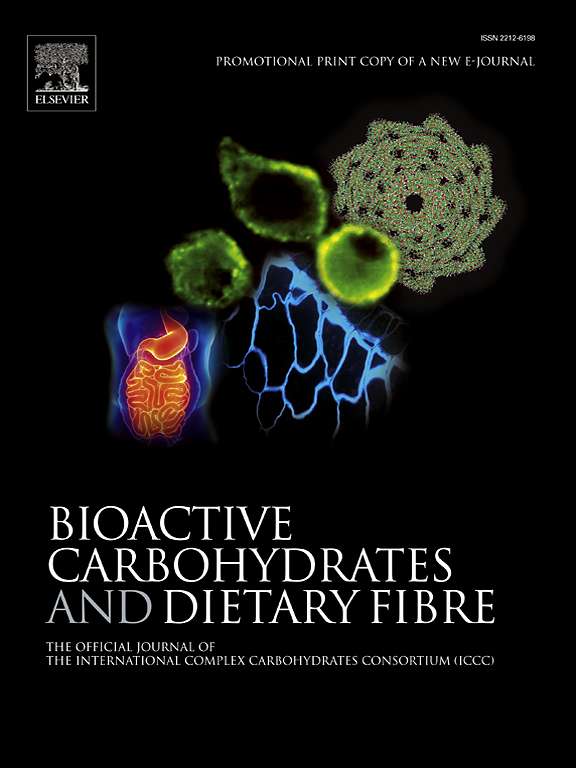The specificity of family 4 carbohydrate-binding modules (CBMs) of BpGH16MLG influences the binding and utilization of β-glucans in a human gut bacterium, Blautia producta
IF 3.6
引用次数: 0
Abstract
Several thousand bacterial communities reside in the human gut environment and have acquired numerous genes during co-evolution for trapping dietary nutrients. Many of Gram-positive bacteria encode extracellular cell wall membrane-bound endolytic enzymes with non-catalytic carbohydrate-binding modules (CBMs) that recognize cognate glycan(s). Much remains unknown about how these organisms recognize nutrients in the gut environment. Blautia producta JCM 1471T expresses a cell membrane-tethered endo-acting enzyme (BpGH16MLG-digesting barley-β-glucan, lichenan, and laminarin) with four carbohydrate-binding modules (CBM4_1, CBM4_2, CBM4_3, and CBM4_4). Each CBM4 and its dual combinations were cloned, characterized, and assessed with three distinct β-glucans (barley-β-glucan, lichenan, and laminarin). It was observed that each CBM4 recognizes barley-β-glucan and lichenan with approximately equal affinity. Dual combination, CBM4_1-CBM4_2 exhibited a substantial predilection for barley-β-glucan, whereas CBM4_3-CBM4_4 had an affinity for barley-β-glucan and lichenan. None of the dual combinations showed an affinity for laminarin. Intriguingly, a mutant (E384A-catalytic base) version of BpGH16MLG with all CBM4 domains showed high binding to barley-β-glucans and lichenan, but moderate binding to laminarin. This understanding provides insights into how B. producta recognizes and likely traps specific nutrient in the gut environment. Furthermore, the study may have implications for the development of innovative biocatalysis.

BpGH16MLG家族4碳水化合物结合模块(CBMs)的特异性影响β-葡聚糖在人肠道细菌Blautia producta中的结合和利用
数千个细菌群落生活在人类肠道环境中,并在共同进化过程中获得了许多基因来捕获膳食营养。许多革兰氏阳性细菌编码胞外细胞壁膜结合内溶酶,其非催化碳水化合物结合模块(CBMs)可识别同源聚糖。关于这些生物如何识别肠道环境中的营养物质,还有很多未知之处。Blautia producta JCM 1471T表达一种具有四种碳水化合物结合模块(CBM4_1、CBM4_2、CBM4_3和CBM4_4)的膜系内作用酶(bpgh16mlg),可消化大麦-β-葡聚糖、地衣素和层粘连素。对每个CBM4及其双组合进行了克隆、鉴定,并用三种不同的β-葡聚糖(大麦-β-葡聚糖、地衣聚糖和层粘连素)进行了评估。结果表明,CBM4对大麦-β-葡聚糖和地衣聚糖具有近似相等的亲和力。双组合CBM4_1-CBM4_2对大麦-β-葡聚糖具有明显的亲和性,而CBM4_3-CBM4_4对大麦-β-葡聚糖和地衣具有亲和力。两种组合均未显示出对层粘连蛋白的亲和力。有趣的是,具有所有CBM4结构域的BpGH16MLG突变体(e384a -催化碱基)与大麦-β-葡聚糖和地衣素的结合程度高,但与层粘连蛋白的结合程度中等。这一认识为了解B. producta如何识别和可能捕获肠道环境中的特定营养物质提供了见解。此外,该研究可能对创新生物催化的发展具有启示意义。
本文章由计算机程序翻译,如有差异,请以英文原文为准。
求助全文
约1分钟内获得全文
求助全文
来源期刊

Bioactive Carbohydrates and Dietary Fibre
Agricultural and Biological Sciences-Food Science
CiteScore
6.00
自引率
0.00%
发文量
38
期刊介绍:
 求助内容:
求助内容: 应助结果提醒方式:
应助结果提醒方式:


